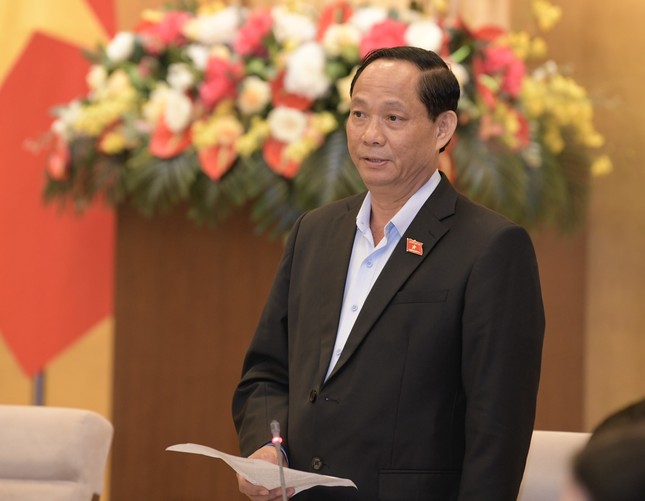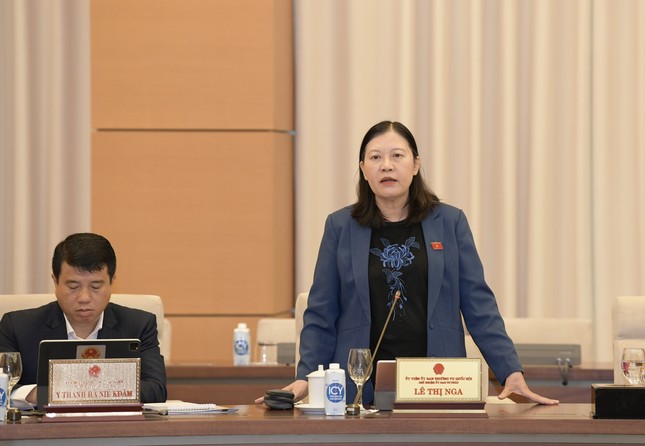The reason for the 15-meter depth limit
On the morning of March 14, the Standing Committee of the National Assembly submitted opinions on the draft Capital Law amendment. During the session, the Standing Committee on Legal Affairs asked for the opinion of the Standing Committee of the National Assembly on the specific determination of the underground space limits for land users (Article 19).
According to the Chairman of the Committee on Legal Affairs, Hoang Thanh Tung, the draft law currently has two design options for this content.
In which, option 1 stipulates that the land user is allowed to use the underground space in a vertical manner within the boundary of the land plot from the ground surface to a depth of 15 meters.

Vice Chairman of the National Assembly, Tran Quang Phuong. Nhu Y
In addition to this depth limit, land users can still use the land if it is suitable for planning but they must obtain permission from the competent state agency and pay a fee as regulated by the Government.
“The determination of the 15-meter depth limit is based on the functional zoning scope determined in the General Planning for Underground Construction Space in the central urban area of Hanoi city until 2030, with a vision until 2050”, Mr. Tung said.
This option will provide a legal basis for Hanoi city to actively manage, exploit, and use underground space efficiently, clearly define the limits of underground space used by land users.
Option 2 will assign the Government to determine the limit of depth that land users can use; other content is similar to option 1.
According to Mr. Tung, this option has the advantage of allowing land users to determine the depth limit of land use more flexibly, in accordance with the geological characteristics and potential for exploitation and use of underground space in each area.
As this is also a new content, without practical testing, if the Government is assigned to specify the details, during the implementation process, if there are any obstacles or shortcomings, the Government will timely revise and supplement them.
However, determining the rights of surface land users in the use of underground space actually limits the rights of land users. Therefore, according to the provisions of the 2013 Constitution, this content needs to be regulated in the law of the National Assembly.
“The majority of opinions in the Standing Committee on Legal Affairs and the agencies agreed with option 1”, Mr. Tung said.

Chairperson of the Justice Committee, Le Thi Nga. Nhu Y
Continue research and impact assessment
Giving opinions on the management and use of underground space, Secretary-General of the National Assembly Bui Van Cuong said that this was a difficult and complicated content and a concern of many large cities around the world, not only in our country. In fact, many countries are implementing the management and use of underground space very well.
Compared to the draft submitted to the National Assembly, this draft has two new options. The Secretary-General of the National Assembly agrees with option 2, assigning the Government to determine the depth limit that land users within the Hanoi urban area can use the underground space in a vertical manner, to create flexibility and flexibility for the Government and Hanoi city, avoiding difficulties in implementation for each specific case.
Meanwhile, Chairman of the Committee on Science, Technology, and Environment Le Quang Huy noted that determining the 15-meter depth limit is based on the functional zoning scope determined in the overall planning for underground construction space in the central urban area of Hanoi city until 2030, with a vision until 2050.
According to him, this option will provide a legal basis for Hanoi city to actively manage, exploit, and use underground space efficiently, clearly define the limits of underground space used by land users, transparentize the rights and responsibilities of land users, create favorable conditions for exploiting the added value of land and implementing the construction of urban railway systems.
Regarding the specific determination of the limit of underground space used by land users, Chairwoman of the Committee on Justice Le Thi Nga said that there is currently no regulation in the law, so it needs to be prescribed according to the framework, assigning the Government to determine the details.
With regard to this issue, Vice Chairman of the National Assembly Tran Quang Phuong suggested continuing research and assessing the impacts, while referring to international experience to prescribe appropriately, in order to proactively manage, exploit, and use underground space efficiently, transparentize the rights and responsibilities of land users, and create favorable conditions for exploiting the added value of land.
At the same time, Vice Chairman of the National Assembly proposed that the law should also specify the specific limit of depth that land users can use.





































